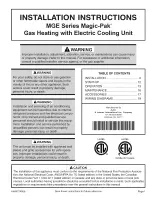
Glass Pro Inductor
11
Removing a window
1. Remove a reveal molding, if applicable. Some windows have encapsulated moldings that can not
be removed. Encapsulated windows can also be removed without damage since the CarDuction
only heats metal objects. Some windows have metal moldings, which need to be removed prior to
applying heat with the CarDuction. The CarDuction will heat the metal nearest to the Glass Pro
Inductor or other heating heads. If the metal trim can’t be removed, it will be necessary to heat the
pinch weld from inside the vehicle.
2. Although not always necessary, it is recommended that the interior trim be removed from the
vehicle to minimize the possibility of burning the trim. Removal of the interior trim also exposes any
additional hardware such as clips and studs that may be holding the window in place. Such
hardware will need to be released prior to the removal process. Locating the position of the
urethane bead is also easier with the interior trim remvoved.
3. Disconnect antennas and defroster grids.
4. To prevent scratches to the painted surface that could be caused by wooden or plastic wedges,
place a layer of masking tape around the perimeter of the painted surface as close as possible to
the glass or molding.
5. Place a clean layer of masking tape over the pole pieces of the Glass Pro Inductor to prevent
scratching the glass as the Glass Pro is moved back and forth over the glass. Replace the tape
every time another glass is to be removed.
6. Clean the glass thoroughly before starting the removal process
7. Always start the removal process near the area of the vehicle where the repair is to be made. The
greatest risk of paint damage by the wedges is at the starting point of the glass removal due to the
difficulty of getting the first wedge in place. It’s best to start in a corner if possible and progress
around the window towards the undamaged area of the vehicle.
8. Ideally the Glass Pro Inductor should be placed directly on top of the urethane for efficient window
removal. However, some vehicles have narrow pinch welds that cause the Glass Pro Inductor to
be too close to the painted surface, putting unnecessary heat into the area possibly burning the
paint. In some cases a damp towel or heat sink compound may need to be applied to absorb the
heat being put into the painted surface. (See illustrations) If possible, keep the heating attachment
at least 1 inche away from the edge of painted surface.
9. Generally the urethane is located at the inner edged of the pinch weld. To locate the pinch weld,
place hand piece of Glass Pro on inner side of window about 4” away, parallel to the edge or flange
of window opening.
10. Set the unit to maximum output then turn the unit on and notice the indicator on the meter located
on the top of the unit. It will move slightly above zero. Slowly move hand piece toward the outer
edge of the window (maintain parallel orientation of attachment to edge of glass) and monitor the
meter as doing so. The meter will begin to increase as you move closer to the pinch weld. The
more metal that is near the heating attachment, the higher the meter will read. Maximum output
from the unit is approximately 7 on the meter (The maximum value is affected by they type of metal
and thickness of the metal). It is not necessary to max out the meter. Once the meter starts to
increase from its nominal position, move another ¼” (6mm) closer to the edge. The heating
attachment should be located over the edge of the pinch weld while maintaining maximum
distance from the painted surface. Visually note the distance between the edge of the glass and





































